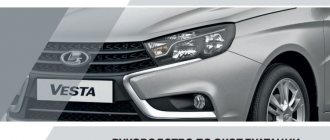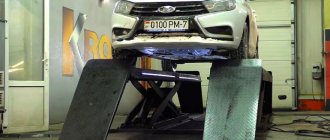Enough time has passed since the launch of mass production to objectively consider all the shortcomings of the Lada Vesta. Although it’s worth starting with the fact that in many ways AvtoVAZ’s new product met consumer expectations:
- good handling for cars of this class;
- roomy trunk and spacious interior (if we compare Vesta with competitors such as Solaris and Rio);
- decent security system;
- stylish appearance;
- many useful standard options implemented by the plant for the first time.
But even the leaders of the global automobile industry do not have ideal cars - there are always pros and cons, and the latter often arouse more interest.
Lada Vesta
Disadvantages of the interior
The new Lada Vesta at first does not raise any questions about the interior, but over time some assembly problems may appear. Most often, these are crickets and creaking parts - a clear sign that the manufacturer has saved on seals. The steering wheel cover also leaves much to be desired - the paint wears off very quickly.
The disadvantages of the Lada Vesta's interior are complemented by the low quality of plastic: the parts are hard and look cheap. Although the owners say that such material is more convenient to wipe off dust.
Putting aside complaints about materials, you need to pay attention to the weak points of the dashboard: poor data readability, some additional indicators are too small, and the view of the upper part of the instruments is partially obscured by the edge of the “well” and the steering wheel.
Dashboard
But the comfort of the Lada Vesta can be classified more as an “advantage”, but this is if you close your eyes to the awkward driver’s armrest and the lack of it for the front passenger.
Suspension
There was a problem with the stabilizer bushings. I suffered for a long time with the creaking, it’s not particularly pleasant to drive over speed bumps. I had to constantly lubricate it, then I installed bushings and brackets from Kia Rio, and forgot about the problem. Now AvtoVAZ has switched to a new type of stabilizer; it took 4 years to correct the jamb.
The suspension is energy-intensive, does not break through, but there is a lot of noise on small bumps (rattling on the left).
AMT robotic transmission
The assessment of an auto expert or the opinion of an ordinary driver will certainly affect the transmission that is not the most successful. The new “robot” produced by VAZ is, in fact, a modernized manual transmission VAZ-2108. And these boxes have always had the problem of oil starvation of the upper shafts. In addition, the Lada Vesta is deprived of the oil level in the transmission.
The car's shortcomings also manifest themselves in increased wear of synchronizers, which has always been characteristic of gearboxes of this series.
The AMT has a clutch from Valeo. Despite the quality, it can fail after 80 thousand km, and replacing it is not a cheap pleasure.
Many drivers of the Lada Vesta complain about such problems as failures when changing gears and a delayed transition to second gear. So on your first trips it is very likely that you will experience negative emotions when accelerating.
But the robotic transmission is not hopeless and, in terms of settings, is comparable to expensive cars. And with a “traditional” automatic, fuel consumption would be less economical.
Guarantee
This car comes with a classic warranty of three years or 100 thousand kilometers, whichever comes first.
However, the warranty period for suspension parts is 2 times less - 50 thousand mileage. This
- steering rod bushings;
- racks;
- tips;
- anti-roll bars;
- silent blocks;
- ball and rubber-metal joints.
Electrically it's
- switches and switches;
- headlights.
Other
- Handbrake cables, brake hoses, fuel pumps, expansion tank
The battery warranty is two years.
A number of Vesta elements are guaranteed for a period of one year or 35 thousand mileage. This
- shock absorbers;
- catalyst;
- rolling bearings.
However, the entire body is guaranteed against perforation corrosion for 6 years.
Rapid contamination
There is too much clearance in the hood latch area, allowing dirt and water to enter the engine from the outside. As a result, Vesta owners are forced to resort to cleaning the engine compartment more often and installing various seals.
Large gaps in the housing
Large gaps in the housing
Rapid contamination is also typical for the body. Most likely, the reason is the large wheel arches, and the X-shaped imprints also play a role in collecting dirt. In addition, the lack of edges on the windshield affects it and, as a result, the side windows quickly become clogged.
Another drawback of the Lada Vesta is associated with the side windows - very poorly selected seals. Because of them, dirt gets inside the door, which subsequently leads to scratches.
It is also worth remembering ineffective windshield wipers, which some car owners change without hesitation. Standard wipers not only fail to do their job, but also begin to leave scratches over time.
WE MADE IT FROM WHAT HAPPENED...
The marketing policy of Vesta is such that it is served under the sauce of patriotism, the first domestic car that you can be proud of, although they try to keep silent about the fact that control and the main stake in AvtoVAZ OJSC belongs to the Renault-Nissan alliance, and the Rostec state corporation owns only 24, 5%.
And to what extent is Vesta a Russian car? By the way, the name itself, Vesta, from the Latin Vesta, (ancient Greek Ἑστία) is a goddess, the patroness of the family hearth and sacrificial fire in Ancient Rome.
The beloved design is the work of the Englishman Steve Mattin, who drew Mercedes and Volvos. It seems that the platform is a long-standing development of VAZ engineers. But if you look into it, it has undergone many changes, it has a new front suspension with L-shaped arms, a new rear semi-independent beam, steering from Renault Megane, even the brakes and radiator are borrowed from Renault-Nissan developments, and that’s not all.
There is also a suspicion that the abundance of safety systems so unusual for the basic configuration: ABS+BAS, EBD, ESC, TCS, HSA (which, by the way, is also not an AvtoVAZ development) was necessary in order to teach this new platform to drive decently, and, in fairness, the engineers succeeded with 5 points.
Or perhaps these are games of marketers who, using uninformative combinations of English abbreviations, are trying to evoke associations with a higher class among potential buyers. After all, if the anti-lock brake system (ABS) with brake force distribution (EBD) is already a minimum even for this class, and the exchange rate stability system (ESC) is very useful in winter, then the presence of a hill start assist system (HSA) and traction control systems (TCS) with the VAZ 1.6 engine raises more questions than approvals. Maybe it’s better to leave something like this for an optional extra, otherwise in the base of the restyled Vesta we may see a night vision system with pedestrian recognition and a parking assistant. It is also not yet clear whether there is any benefit and how the ERA-GLONASS emergency warning system, which is the highlight of the new Lada, will work in Russia, because cars even several classes higher do not offer this.
engine Lada Vesta VAZ-21129
The VAZ-21129 engine retained the greatest authenticity, although modifications to the air intake system, exhaust, etc., deprived it of the much-loved beak-like sound, recognizable long before the appearance of the pelvis falling due to the turn. But this engine is not the strong point of the car, in comparison with competitors, not in terms of power, not in efficiency, not in reliability.
Also, the robotic gearbox is allegedly completely and entirely the development of AvtoVAZ; in fact, to develop the “robot”, they took an ordinary manual gearbox as a base and added a computer and drives from the German company ZF. However, even though this is a cheaper analogue of an automatic transmission with a torque converter, all Vesta video reviewers agreed that in the author’s summary it will sound like a “shithole”, which can only be taken if you don’t understand at all why three pedals, if there are two legs, because the operating algorithm causes cognitive dissonance, requires a long time to get used to, and may always irritate you with its thoughtfulness.
And if the authoritative publication Autoreview, No. 19, 2015 – October 2015 wrote in a comparative test:
There are no complaints about the operation of the selector of the “robotic” Vesta, but the acceleration is sluggish: 15 seconds to “hundreds”!
and the authors of the “Big Test Drive” Stillavin and Vakhidov generally made it “exclusive” that Vesta’s box was tuned by Porsche, which is supposedly a secret (although why would it be? Lada doesn’t want anything to do with Porsche, or the latter are ashamed of their work), then “Fox Rulet” found out from the managers of the car dealership that it was the lack of a normal automatic transmission that was the reason for the failure of sales of the Lada Vesta in the Moscow region.
Therefore, if you know how to use a “handle,” it is better to give preference to the mechanics developed by the Nissan-Renault alliance, or wait for the promised CVT.
In general, how great is the intervention of foreign engineers and technologies is indicated by the initial level of localization of Vesta - 71% (in a broad sense, when calculating localization, not only components and spare parts produced within Russia are taken into account, but also all costs associated with ensuring the production of cars - water, electricity , workers' wages and much more).
By comparison, the Moscow company, which produces Renault Logan, Sandero, Fluence, Latitude, Duster and Koleos, already reached 75% at the beginning of 2013. Hyundai Solaris localization level | KIA Rio and Volkswagen Polo | Skoda Rapid is in the region of 50%. It was not possible to find the exact percentage of localization of Ford Fiesta, it is only known that in 2013 for the entire model range it was 40%, goals were set to increase the level, relevant agreements were signed with the Ministry of Economic Development of the Russian Federation, but judging by the current price, something went wrong according to plan.
And on little things...
Some of the disadvantages of the Lada Vesta listed below can be attributed to nit-picking and not to serious shortcomings, but they still exist and create inconvenience for car owners:
- narrow pedal assembly;
- insufficient rear visibility;
- frequent malfunctions of the heated windshield;
- excessive sensitivity of ABS fails;
- no lock on the gas tank cap
- Incomprehensible operation of the central locking.
In general, eliminating factory defects for AvtoVAZ is one of the priority tasks in the policy of improving product quality. It is important for consumers to contact their personal managers in a timely manner not only with serious problems, but also with minor defects, thus making their contribution to the elimination of factory defects by the plant.
Technical equipment
AvtoVAZ promised huge variability in the choice of trim levels and additional equipment, justifying it with the fact that everyone would be able to “make” a car for themselves. And the company kept its word. Vesta offers three different configurations: classic, comfortable and luxury.
The classic version of Vesta offers a choice of 11 different options, which is truly a lot. Lada also offers 12 color schemes in classic and comfort, and for the luxury version it is possible to combine several colors.
It's hard to find any shortcomings in the engine lineup. The weakest of them is 1.6 liters and 87 horsepower with a 5-speed manual. The most powerful is 122 horsepower, 1.8 liters and automatic transmission. Considering the budget class, Vesta offers decent engine options.
Vesta is a great car for every day
Mikhail, Rubtsovsk . I recently purchased this AvtoVAZ model and have never regretted it. There are no problems yet, nothing breaks. At first I thought about buying a new Toyota, but when I looked at the money, I was horrified. The difference is half a million rubles. This takes into account that Vesta is in the “maximum” class, and Toyota is in the middle class. There is no difference in their functions; our car even wins in some respects. Therefore, think for yourself whether 500 thousand is extra for you or not. I can only leave positive feedback about the machine.
Extended Lada Vesta.
Equipment
The passive safety of the model suffers due to the lack of airbags for the rear seats, a drawback noted by many car owners. At the same time, positive reviews draw attention to the full range of safety systems, both active and passive. Speed control is noted.
There are standard complaints about the quality of the sound system speakers: “Nothing”, “There is music, and that’s okay.”
But at the same time, changing the speakers if he needs a deeper or more pronounced sound will not be a problem for the car owner.
There are also problems with sound insulation; at speeds up to 80 km/h, the interior is an oasis of calm; when it is exceeded, slight aerodynamic noise appears.











